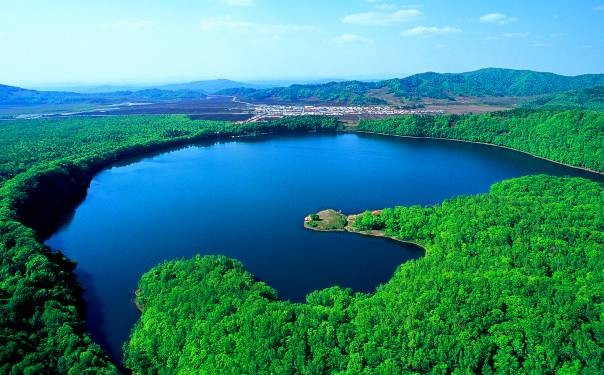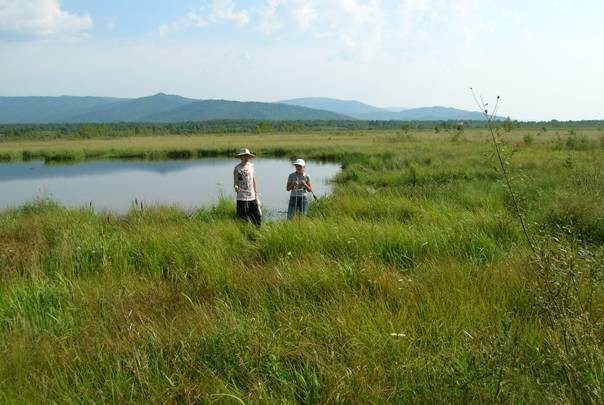龙湾野外试验站
Longwan Wetland Ecosystem Research Station
Introduction of research station
The Longwan Wetland Ecosystem Research Station (DBWERS, 126°23′E,42°21′N) was established in July, 2003, which is located in the Longwan National Nature Reserve (DBNNC) in Huinan County of Jilin Province.
Known as the largest crater lakes cluster in China, the Reserve (126°13′-32′ E, 42°16′-26′ N) is sited on the Longgang Mountain, a spur of Changbai Mountain range. It is also the cradle of Huifa River, the main branch of the Songhua River. The Reserve is famous for nemorous crater lakes, dormant volcanoes and quake lakes. The special and typical volcano landscape here is unusual in China, not only because of obvious differences of shape, size and depth among those crater lakes and quake lakes, but also the various types of wetlands, including marshes, forest swamps, shrub swamps, quaking bogs at different development phases, which is regarded as an optimal site to study the succession of wetland ecosystem in terms of both vegetation and paludification.
 The Small Longwan at middle development stage (vegetation is moving to the center of lake)
The Small Longwan at middle development stage (vegetation is moving to the center of lake)

The Dry Longwan at late development stage (there is deep water beneath the cover)

The big Longwan which at earlier development stage (small patch of swamp distributes at the edge of lake)

Jingchuan Marsh resulting from quake lake
The Reserve has a marked continental monsoon climate characterized by four distinct seasons. The annual average temperature is 4.1oC, and precipitation is 704 mm, of which about 61% occurs in summer. The zonal vegetation and soil are Pinus koraiensis-broadleaved mixed forest and dark brown soil, respectively. There are about 474 plant and 279 vertebrate species including 171 birds living in the abundant types of habitat, such as natural forests, reed marshes, open water, swamps and bogs, which is the paradise of wildlife and the key region of biodiversity research and conservation. Among them, about 33 animals and 11 plants are in the National Protected Species List, e.g. oriental white stork (Ciconia boyciana), golden eagle (Aquila chrysaetos), sable (Martes zibellina), mandarin duck (Aix galericulata), Chinese egret (Egretta eulophotes), Asian black bear (Selenarctos thibetanus), spreading yew (Taxus cuspidate), ginseng (Panax ginseng).
-
Function and mechanism of wetland ecosystem
-
Conservation and restoration of wetland ecosystem
-
Resource utilization of forest swamp
Instruments
Open path eddy covariance system: A typical eddy covariance system consists of a datalogger, a CSAT3 three-dimensional sonic anemometer, a LI-7500 open path infrared gas analyzer (IRGA), Energy balance sensors, and a HMP45C temperature and humidity probe. With this configuration, the system can measure carbon dioxide flux, latent heat flux, sonic sensible heat flux, momentum flux, a computed sensible heat flux, temperature, humidity, horizontal wind speed, wind direction, net radiation, soil heat flux, soil temperature.
Weather station: can measure wind speed, wind direction, air temperature, relative humidity, soil temperature, precipitation, pressure, radiation, and ultraviolet radiation.
CI-340 portable photosynthesis analyzer: is a lightweight hand-held photosynthesis system. The entire system - display, keypad, computer, data memory, CO2/H2O gas analyzer, flow control system, and battery - is contained in a single hand-held case. It has everything you need to measure photosynthesis, transpiration, stomatal conductance, and internal CO2 concentration, as well as many other factors. It can also control temperature and light intensity with the optional temperature and light control modules. Furthermore, the CI-340 can precisely control CO2 and H2O concentrations in the leaf chamber.
CI-110 Digital Plant Canopy Imager: can capture and analyze fish-eye (150°) images. The software calculates leaf area index of the canopy, gap fraction, hemispherical diffuse radiation transmission coefficients (the sky view factor), mean foliage inclination angles, and plant canopy extinction coefficients.
Long term ecological monitoring
Characteristics of dominant species community
To measure height, density, cover, abundant, richness, aboveground biomass, belowground biomass, LAI, standing litter, litter biomass at August.
Physiological traits of dominant species
To measure photosynthesis, transpiration and respiration once a month during plant growth period.
Soil characteristics of dominant community
To measure soil content, texture, bulk density, permeability rate, pH, salinity, organic carbon, dissolved organic carbon, total nitrogen, nitrate, ammonium
Hydrology and water chemistry of river and wetland
Facilities
The building includes laboratory and dormitory.
Projects conducted in the field station
-
Functional type of wetland ecosystem of Jilin province
-
Conservation and restoration of wetlands
-
Succession of wetland vegetation and the possible drive mechanisms
-
Water resource and hydrology in wetland ecosystem
-
Amount and translation of organic carbon flux through air-plant-peat interface
-
Energy exchange and climate change of wetland ecosystem
-
The response of wetland vegetation to global climate change